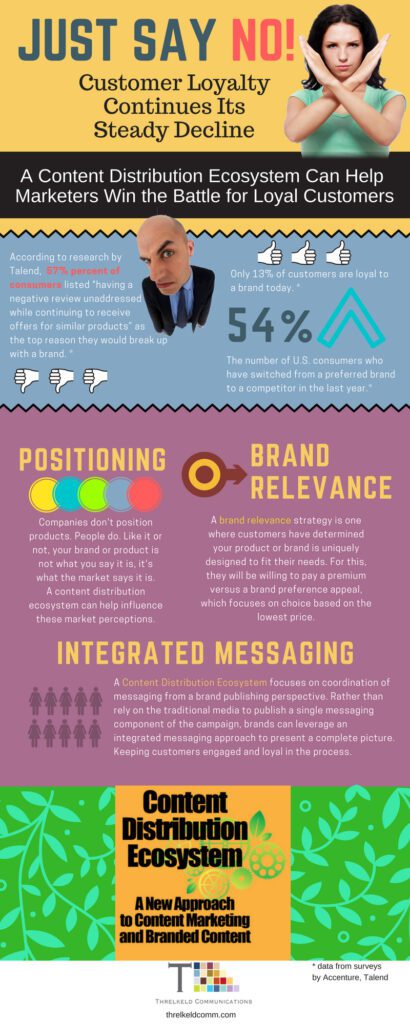Is Your Marketing Creating Sales for Your Competitors?

In a perfect world, awareness marketing drives customers to take a desired action. This action could be a top of the sales funnel activity, such as clicking on a link to learn more. Or, a deeper sales funnel action such as clicking on a link to buy from your email newsletter.
But, as we know, we don’t live in a perfect world.
This leads to a troubling question: Is the money and time you are spending on awareness marketing driving sales for your competitors? This could actually be the case. In this blog post, I’ll explain why this may be happening, and what you can do to correct it.
The primary reason awareness marketing could be hurting your sales has to do with the connection between the awareness trigger and the critical action step in the buyer journey. For example, let’s say you’ve created a great lead page program that incentivizes a potential customer to click on a link, visit a dedicated landing page, enter an email address and download an informational eBook on the benefits your product offers. Great! The marketing lead program has done its job. It’s built a case for the value proposition and incentivized a potential buyer to give you their information, while you educate them on the need for your product.
But what happens next? Let’s say that potential customer reads the eBook and loves the problem/solution value proposition your product offers. So they head to Google and do a search on your product or brand.
Guess what? The first few results they see are paid ads for a similar product in the same category offered by your competitor. Then, in the organic section of the search (just below the sponsored ads section), they see a relevant subject blog post on your key competitor’s website. The blog post links to a customer testimonial touting the benefits of your competitor’s product (which sound very similar to the ones you claim for your product).
The potential customer clicks on the link and scans the blog post to ensure the content is relevant. Next, they click on a link to an audio podcast interview with the customer. After listening to that, they head back to Google for a little more research. About halfway down the results page, there is a mention of your product in an obscure sounding post from an online outlet that they’ve never heard of, so they don’t click.
They do a search on your brand to find out where they might be able to buy and no retail links appear. But they do for your competitor. So guess what? The customer clicks on the competitor’s link and buys the product (incentivized by the fact they’re offering free shipping).

So what happened? In a matter of minutes, a curious customer triggered by interest created by your excellent awareness marketing went from potential buyer to lost sale because the customer journey did not pay off the value proposition you created with your great awareness marketing efforts.
In this, the age of the disloyal customer, this scenario is all too familiar. Check out this infographic showing the growing trend for disloyalty in today’s competitive marketplace.
So what’s the answer? There are two critical steps you need to take to help lessen the chance of this happening.
First, you need to look at your awareness efforts from an integrated messaging perspective. I call this a content ecosystem approach. It essentially means that, in planning and executing your awareness marketing programs, you must think from a publishing perspective as opposed to a marketing perspective. In other words, “what can we do to have as much control and as wide of a footprint as possible over how our message gets communicated?”
This means you need think of your awareness efforts from an integrated editorial campaign perspective. So, when creating awareness, you look beyond a single trigger (such as a press release, Facebook ad, blog post, etc) and you launch a coordinated, integrated messaging campaign that features a consistent core brand message thread throughout.
In planning this campaign, you identify the primary message point — a singular idea or theme you want the potential buyer to take away — and highlight that in every touch point of the editorial campaign. So, that message is embedded in the headline of the press release that gets posted on your website and distributed via the newswire. It’s the response to a question you ask a customer advocate about in a phone interview that gets posted as a podcast online. It’s a key featured story in the monthly email newsletter you send out. It’s a featured post on Facebook and Twitter. You get the idea.
The goal is, from a brand publishing perspective, create an ecosystem of connected content that reinforces your core messaging statement consistently. And launch that messaging together, so it creates a connected content ecosystem that a consumer can step through.
The second step has less to do with marketing and more to do with the symbiotic relationship between sales and marketing. If your sales pipeline and distribution network is not set up to “close the sale,” you will find that your awareness marketing is doing nothing more than building awareness for the brand category in general.
Circling back to this being the age of the disloyal customer, your well-intentioned sales-focused awareness campaign that was intended to drive new sales has just done that for your competitors. (Don’t expect them to thank you for this either!)
Before launching any broad awareness program, step through the final stages of the customer journey for your brand or product. Is it easy to find online? When you click to make a sale, is it streamlined or confusing? Identify all of the places where the process can be disrupted or disconnected and fix them.
The bottom line: Awareness marketing is a very effective way to build the pipeline for increased sales for your brand or product. But, if your awareness efforts are random, scattered and disconnected, you stand the chance of building awareness for the category your brand fits in. And, when that happens, the brand with the strongest presence in the marketplace (whether it be through paid, owned, shared or earned media) will win. Additionally, if your sales structure does not offer a natural extension for the awareness you’ve created, you will find this sale going to the brand that makes it easiest to buy.
If you’d like to discuss positioning for your brand or product, please send me an email.

Bill Threlkeld is president of Threlkeld Communications, a content marketing and public relations agency based in Santa Monica, California. Threlkeld Communications specializes in integrated editorial ecosystem campaigns that utilize PR, Social Media, Blogs, Audio, Video and Email Marketing.
